Delicious Lasagna with Ground Turkey Meat Sauce
This hearty lasagna is layered with cheesy, meaty goodness—fresh mozzarella, creamy ricotta, and a tasty ground turkey meat sauce.
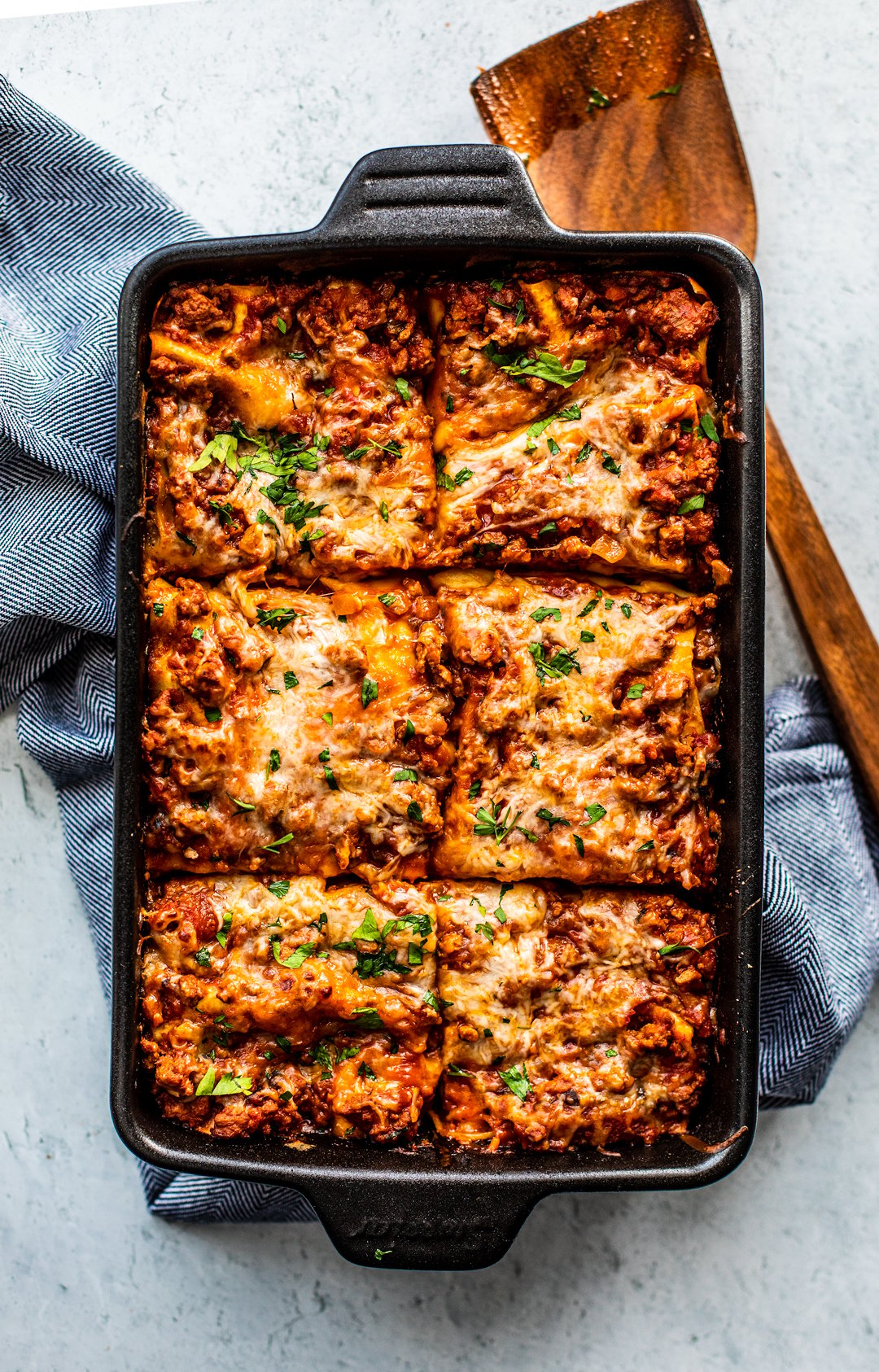
Table of Contents
Why You’ll Love This Lasagna
Lasagna is a staple comfort food: cheesy, meaty, saucy goodness layered between cozy carbs. What’s not to love?
I think what deters people from making this classic themselves is the labor. But it doesn’t have to be complicated. In fact, this recipe spends less than 30 minutes on prep and assembly, so you can totally treat yourself and your loved ones to a yummy cheesy slab of lasagna without fuss!
This recipe lightens things up with delicious tender ground turkey. It’s super flavorful, so you won’t miss the ground beef or Italian sausage.
What to Serve With It
- A simple side salad is a great way to add veggies to balance out the cheese and the carbs. Or you could indulge in a Caesar salad!
- A crunchy chopped cucumber and tomato salad is awesome, especially in the summer time.
- Air fryer green beans are hasty and absolutely delicious.
Quick Tips
From noodle type to that velvety smooth filling, every aspect of a lasagna is important. I’ve made a lot of lasagnas in my life and not all of them have been fabulous. It’s a learning experience!
- No-Boil oven-ready noodles are the best! They’re thin and absorb the sauce nicely as they cook, leaving you with a nice bite and a sturdy enough texture to hold. It’s also a huge plus that you don’t have to pre-boil them—an annoying step completely taken out of the lasagna equation.
- Quality cheese matters. I highly recommend getting yourself a fresh ball of mozzarella and some fresh Pecorino-Romano. You could buy yourself a bag of shredded Italian blend cheese for the top of the lasagna if you want some extra cheese, but stick with the quality cheeses for the layering process. You just won’t get that rich milky flavor that makes lasagna so damn good if you opt for bagged shredded cheese throughout.
- Strain the ricotta. It’s super important to strain your ricotta in order to get that creamy texture you’re after. Skip straining it, and you may end up with a watery mess. See below on how steps for straining ricotta.
- Avoid adding veggies that have high water content. If you want to add veggies, be very careful when it comes to veggies like zucchini, peppers, or fresh tomato slices. Using an abundance of these can make a sloppy lasagna real fast. If you want to add some greens, consider spinach!
- Don’t over-sauce it. Try to use the measurements I’ve provided, even if it looks like it’s not enough sauce. Less is more where lasagna is concerned!
- Finish things off under the broiler. My last tip is to give your lasagna a quick trip under the broiler, uncovered, before taking it out to cool. This will give you some nice crusty bits and it’ll really make that top cheese layer bubble to golden goodness. Just be sure to keep a close eye on it. All broilers are different, and you don’t want to char your beautiful lasagna.
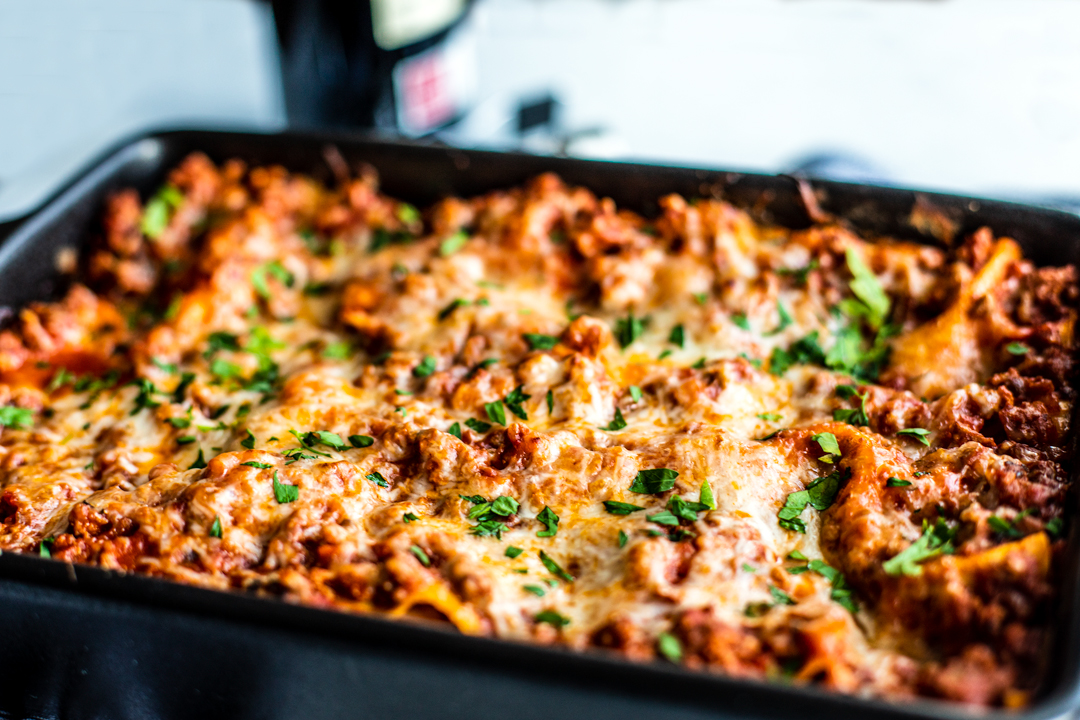
Ingredients
- Lasagna noodles. I love no-boil oven-ready noodles. They will make your life easier and they taste just as good as any ol’ lasagna noodle, honestly.
- Fresh mozzarella. Sure, bags of pre-shredded cheese are convenient and great for so many recipes, but not lasagna. You want the rich, milky flavor from fresh mozzarella.
- Parmigiano-Reggiano. This adds a nice bold sharpness to your cheesy layers. You could also use Parmigiana.
- Whole-milk ricotta. Whole milk brings more flavor and creaminess. Lighter variations tend to be grainy.
- Egg. Adding an egg to the ricotta mixture prevents if from drying out and acts as a binder so it doesn’t get runny.
- Sea salt. To enhance the flavor in the ricotta mixture.
- Fresh parsley. For garnish.
Easy Ground Turkey Meat Sauce
- Extra virgin olive oil.
- Italian plum tomatoes. San Marzano are great, but make sure they’re certified D.O.P. otherwise they are San Marzano “style” but you’ll still be paying the high price. Regardless, any plum tomatoes will do.
- Yellow onion. Adds a nice subtle sweetness to the sauce, but white or red onion will also work.
- Garlic. A lot of it! The recipe calls for 6 cloves, but you can use a bit less if preferred.
- Ground turkey. I recommend a nice 93/7 blend.
- Bay leaves. For a nice subtle flavor enhancement. If you don’t have any, however, that’s fine.
- Fresh oregano. If you have to use dried in place of fresh, use half the amount. But I encourage fresh—it makes the sauce so much fresher!
- Red wine. Go for a nice dry wine, like Cabernet, Merlot, or Pinot Noir.
- Tomato paste. This adds richness and depth to the sauce while also thickening it.
- Chicken broth. To bring on some more flavor and nutrition.
- Salt and pepper.
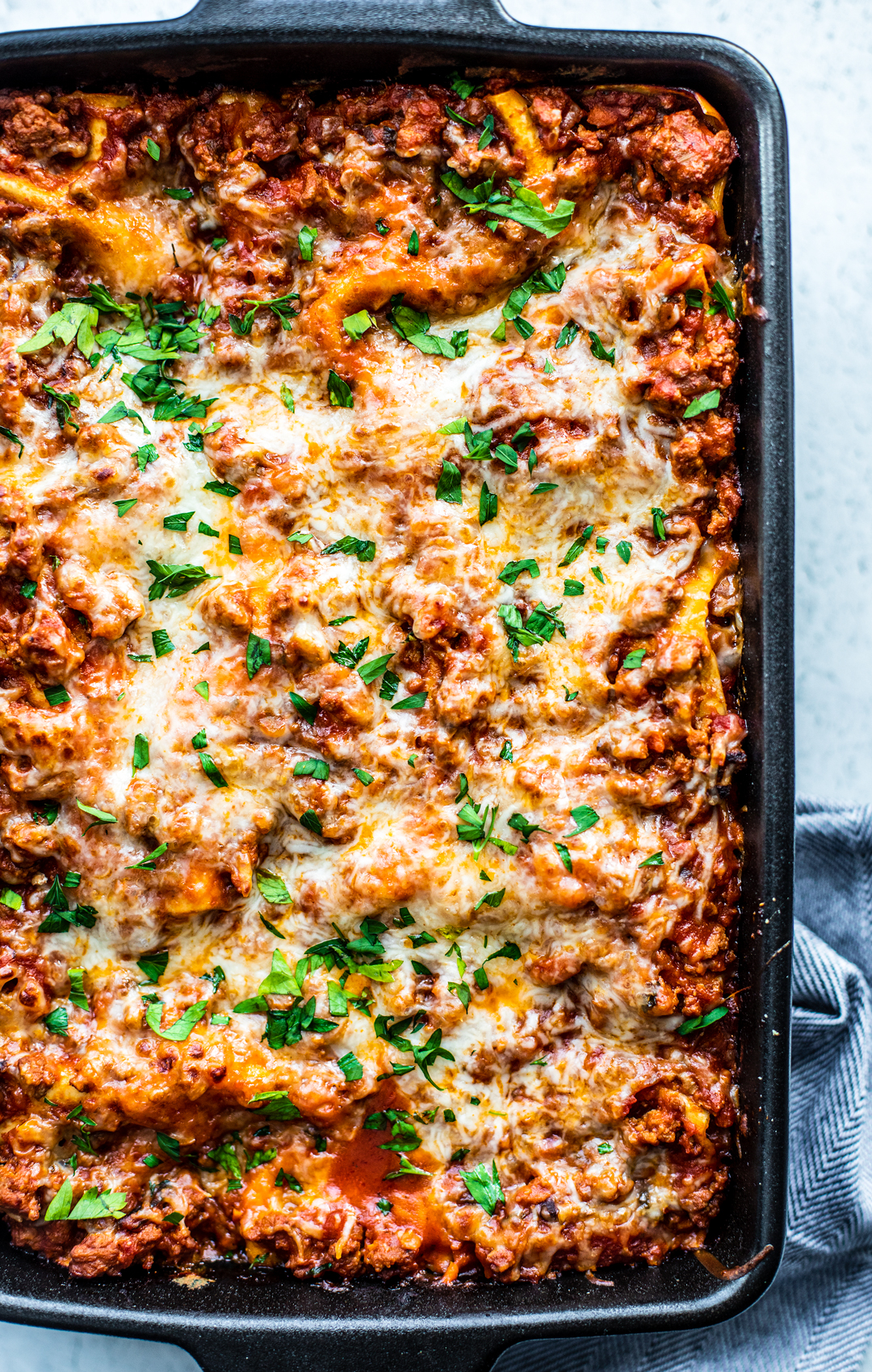
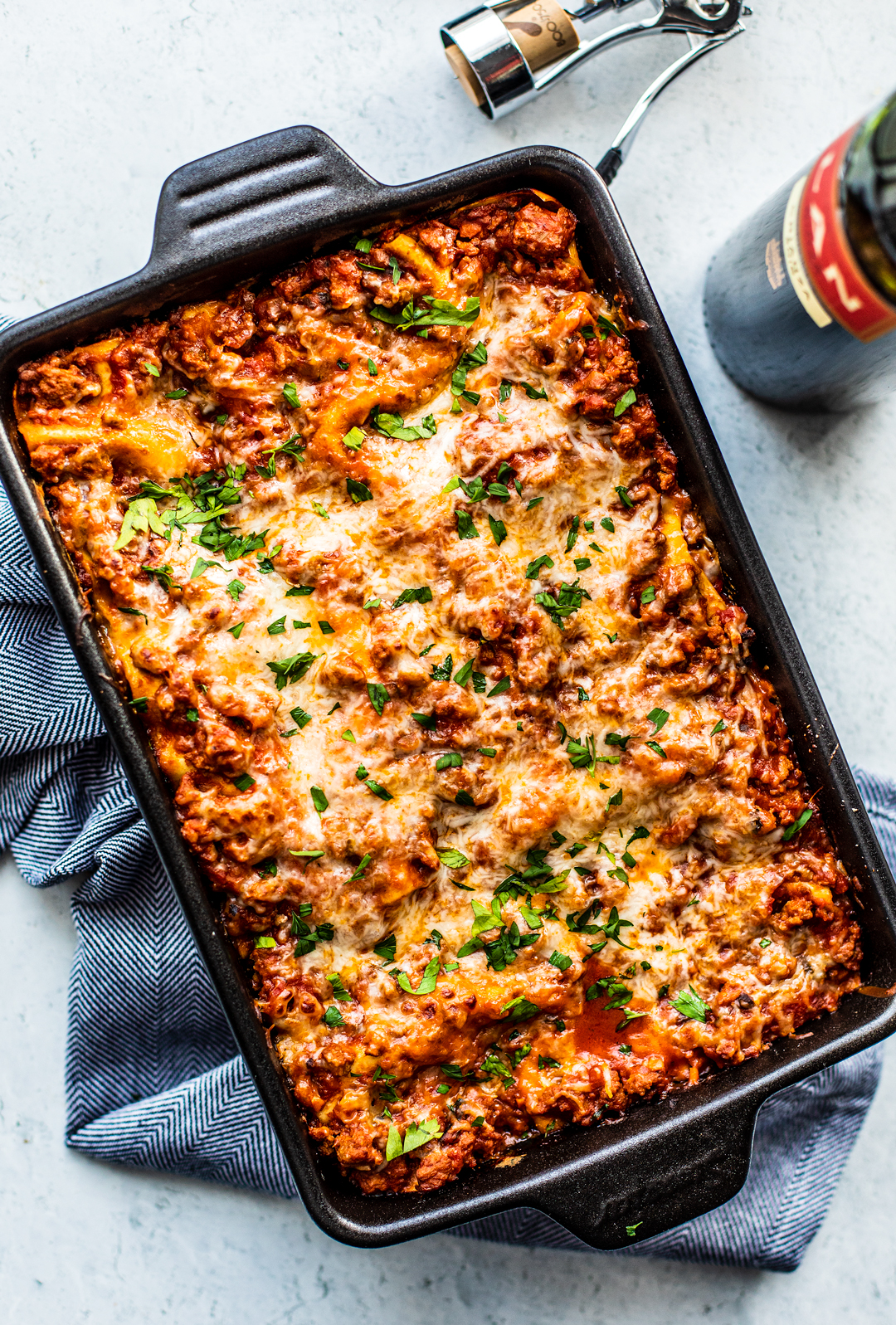
How to Layer a Lasagna
My go-to layering method is from Lidia Bastianich. Her Italian-American recipes cookbook taught me well, and I’ve never looked back.
- Ladle about 3/4 cup of the ground turkey meat sauce into a 11.5 x 8-inch baking dish. (These are the dimensions of the pan I used. You can use something close to that.) Spread the sauce over the bottom to cover as much as you can—it doesn’t have to be perfectly even.
- Arrange noodles lengthwise, side by side, to cover the bottom of the baking dish. Spoon about 2 cups of meat sauce over the noodles to cover the noodles in an even layer. Sprinkle the sauce evenly with ½ cup of the grated cheese.
- Place a single layer of noodles, now crosswise, over the cheese.
- With a spatula, spread the ricotta mixture evenly over the noodles.
- Again, arrange a single layer of noodles, lengthwise, over the ricotta.
- Distribute the sliced mozzarella in an even layer over the noodles.
- Spread 1 cup of the meat sauce over the mozzarella, then sprinkle 1 cup of grated cheese over the sauce.
- Cover the cheese with a layer of noodles arranged lengthwise.
- Spoon enough meat sauce, about 2 cups, over the noodles in an even layer and sprinkle the sauce with the remainder of the cheese.
And there you have it. Layering a lasagna looks tedious on paper, but it’s super simple, goes by quickly, and is well worth it in the end. I find this layering method gives the best cheese-to-noodle-to-sauce ratio. (Thanks, Lidia!)
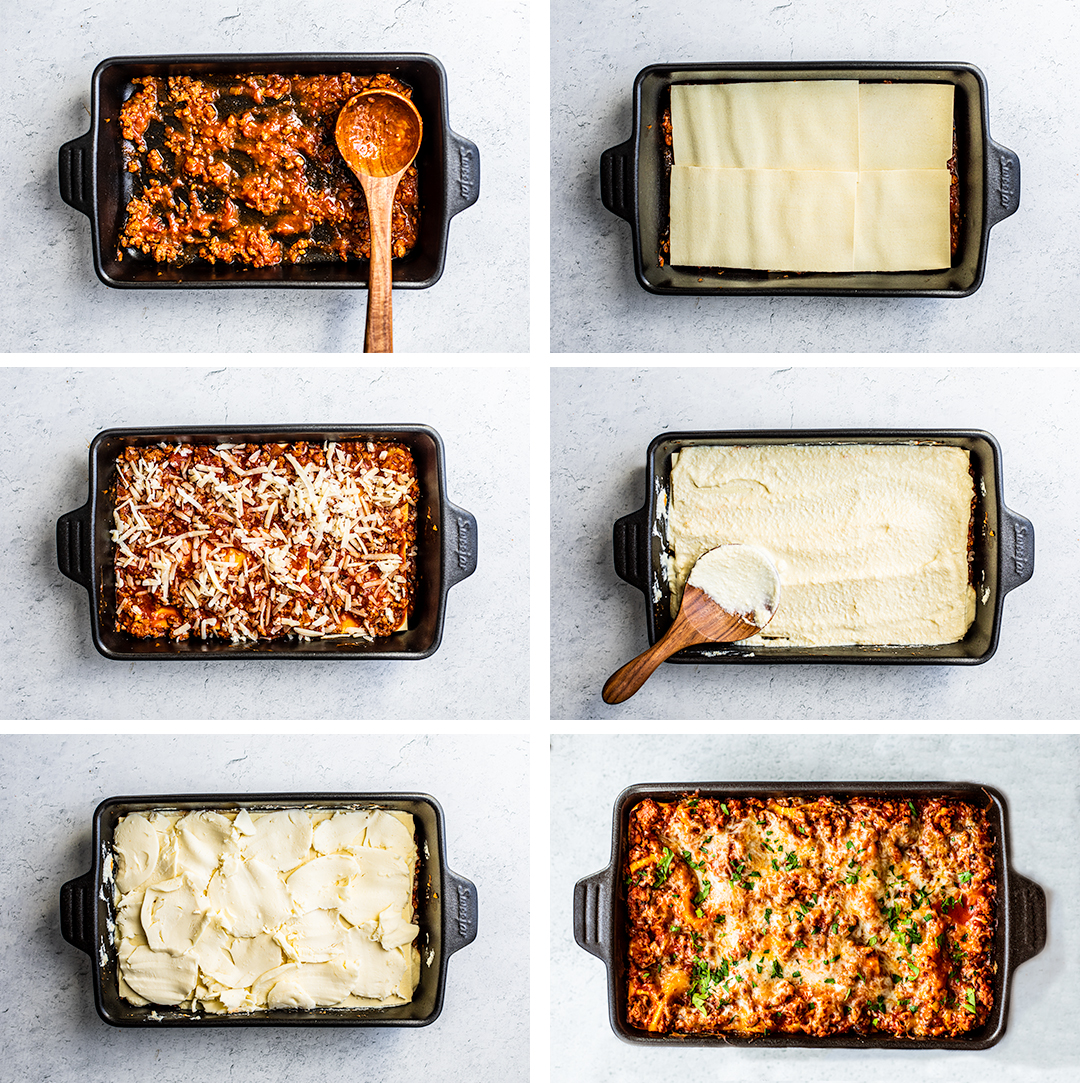
Storage, Freezing, & Reheating
- Leftovers can be left in the fridge for 3-5 days in an airtight container.
- If you plan to freeze the lasagna, your best bet is to freeze it uncooked. When you’re ready to cook it, thaw it in the refrigerator overnight. Remove it from the fridge about 20-30 minutes before baking it (preheat your oven during this time).
- To reheat, warm it up in the microwave in 25 second increments to prevent overheating.
Have You Made This Recipe?
If you enjoyed this recipe, please consider leaving a STAR rating & commenting below with feedback!
You can also show off your creations on Instagram by tagging @killing__thyme
More Ground Turkey Recipes You’ll Love
- Instant Pot Ground Turkey Tacos
- Ground Turkey Meatballs
- Instant Pot Bolognese with Ground Turkey
- Best Turkey Burger
- Ground Turkey Meatloaf
- Garlic and Ginger Turkey Meatballs with Hot Honey Glaze
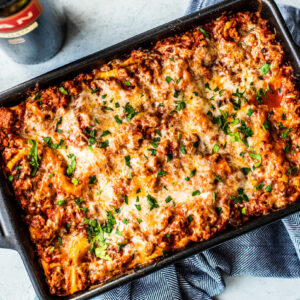
Delicious Lasagna with Ground Turkey Meat Sauce
Ingredients
LASAGNA
- 1 lb no-boil (oven-ready) lasagna noodles
- 2 cups grated fresh Parmigiano-Reggiano cheese
- 8 oz fresh mozzarella, sliced very thin
FILLING
- 1 lb whole-milk ricotta cheese, strained *See notes.
- 1 large egg
- 1/8 tsp kosher salt
GROUND TURKEY MEAT SAUCE
- 1 35 oz can of Italian plum tomatoes
- 1 TBSP extra virgin olive oil
- 1 medium yellow onion, diced (about 1 cup)
- 6 cloves of garlic, smashed, peeled, and minced
- 1 lb ground turkey
- 2 Bay leaves
- 1 TBSP chopped fresh oregano
- 1/4 cup dry red wine
- 1/4 cup tomato paste
- 1/2-1 cup chicken broth
- Kosher salt and cracked black pepper, to taste
Instructions
To make the ground turkey meat sauce.
- Pass the tomatoes through a food mill fitted with a fine disc over a large mixing bowl. Or, you could simply place the tomatoes and their juices into the large mixing bowl and crush them very well with your hands, leaving the sauce a little chunkier.
- Heat the olive oil in a large pot over medium heat. Add the onions to the pot and simmer, stirring occasionally, until slightly golden brown—about 5-7 minutes. Add the garlic to the pot and stir until the garlic has softened and is aromatic—about one minute.
- Transfer the ground turkey to the pot and season it lightly with a few pinches of salt. (You can always add more salt later if needed.) Bring to a simmer, stirring the meat and breaking it down as it cooks, until the meat has changed color and the water from it has evaporated—about 8-10 minutes.
- Add the bay leaves and oregano, then add the wine. Bring to a simmer and scrape away any brown pan bits with a spoon or spatula. Simmer until the wine has fully evaporated.
- Add the tomatoes and tomato paste, and stir until the tomato paste has completely melted into the sauce.
- Add another pinch of salt, bring the sauce to a boil, and let it simmer uncovered for about 2-3 hours. By this time, the sauce should be deep red in color.
- Add a bit of broth at a time as necessary to maintain the level of liquid for the length of time the sauce cooks. You could also use water, but I find broth brings on more flavor.
- When ready, taste the sauce and adjust the seasoning to your preference.
- This sauce will keep in the fridge, in an airtight container, for up to five days and in the freezer for three months.
Ricotta Filling.
- Place all of the ingredients into a large mixing bowl and mix thoroughly; set aside.
To make the lasagna.
- Preheat the oven to 375º F.
- Ladle about 3/4 cup of the meat sauce into a 11.5 x 8-inch baking dish. (These are the dimensions of the pan I used. You can use something close to that.)
- Spread the sauce over the bottom to cover as much as you can—it doesn't have to be perfectly even.
- Arrange noodles lengthwise, side by side, to cover the bottom of the baking dish. Spoon about 2 cups of meat sauce over the noodles to cover the noodles in an even layer. Sprinkle the sauce evenly with ½ cup of the grated cheese.
- Place a single layer of noodles, now crosswise, over the cheese.
- With a spatula, spread the ricotta mixture evenly over the noodles.Again, arrange a single layer of noodles, lengthwise, over the ricotta.
- Distribute the sliced mozzarella in an even layer over the noodles.
- Spread 1 cup of the meat sauce over the mozzarella, then sprinkle 1 cup of grated cheese over the sauce.
- Cover the cheese with a layer of noodles arranged lengthwise.
- Spoon enough meat sauce, about 2 cups, over the noodles in an even layer and sprinkle the sauce with the remainder of the cheese.
- Loosely cover the lasagna with tin foil and bake for 25 minutes.
- Remove the foil and bake for another 5 minutes to brown the cheese; you could also give your lasagna a few minutes under the broiler to really brown the cheese and give youa. few crispy noodles on top.
- Let the lasagna rest for 15 minutes before serving. Garnish with chopped fresh parsley.

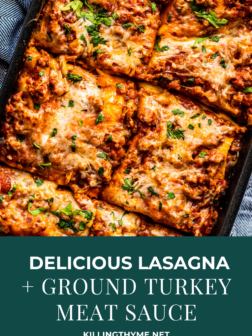

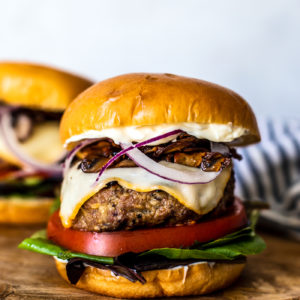
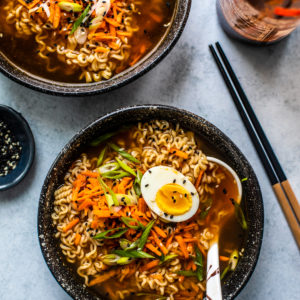

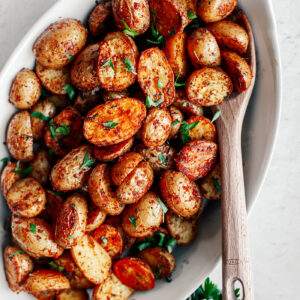




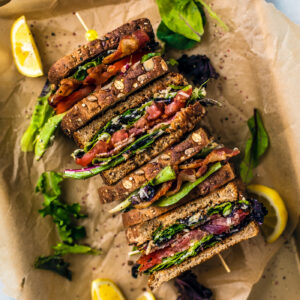
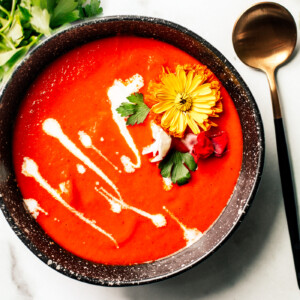


27 Comments on “Delicious Lasagna with Ground Turkey Meat Sauce”
My first time attempting a real lasagna and your recipe made it so easy. YUM!
My husband asked me to put this one in the regular rotation! It was a hit and the leftovers were good too!
Is there anything better than homemade lasagna? I love using ground turkey in this recipe since we don’t eat much red meat. As a garlic lover, I appreciated all the garlic in this delightful recipe!
I love finding new recipes that my family will eat using ground turkey! The flavors in this lasagna are just perfect. Thank you!
We’re huge lasagne fans and this recipe did not disappoint. Even our picky 8 year old wanted seconds. We’ll be adding this to our regular meal planning. Thanks for a great recipe!
Pingback: Ginger Garlic Meatballs With Hot Honey Glaze - Killing Thyme
I ended up without enough meat sauce for the last layer. What did I do wrong?
Hi Jacqueline, a number of things could have technically caused this. One, using a larger baking dish then recommended in the recipe. Another thing would be having used less tomatoes or liquid ingredients wine or broth) than called for. Or, oversimmering and reducing the sauce. I’m sorry it happened! I hope you were able to still enjoy it somewhat.
So can I freeze the assembled lasagna or do I have to cook it, let it cool and then freeze it?
Honestly, you could go either way. If you freeze it, I’d bake it straight from the freezer for about 1 hour and 15 minutes or so, covered with foil. You want it to be bubbling and cooked through. I hope that helps!
Can I assemble this and leave in fridge for the following evening or does it have tp be cooked. Thanks! Worried about the egg in the ricotta.
Hi Frank! You should be totally fine. Just bring the lasagna out and let it come to room temp (about 45 mins or so before you want to cook it) to adhere to the original bake times. I hope you enjoy it!
I made this recipe exactly as specified. It was very good and everyone loved it but I ended up with quite a bit of extra ricotta. Did I read the recipe correctly – only one layer of the ricotta mixture? I had about half left over.
Hey Alyssa! A 1 lb/16 oz container of ricotta should do the trick. I’m wondering if you accidentally bought a 2 lb/32 oz container? I’ve made that mistake so many times before, which is why it’s the first thing that came to mind when I read your comment, haha. The grocery store carries more of the 2 lb containers it seems. And it doesn’t look like a lot, so it’s easy to assume. Any leftover ricotta can be refrigerated for up to a week and stirred into another pasta dish, though. I like to stir mine into a pesto and toss with pasta whenever I have any leftovers. So glad you enjoyed the recipe!
Is there a breakdown of the Protein, Carbs and Fat in this recipe?
Hi Stacy, you can pop this recipe into a program like MyFitnessPal to get an idea.
Love homemade lasagna and this version with the ground turkey meat sauce was outstanding! Definitely making again…makes great leftovers too :)
Yes! Gotta love yummy leftovers. So glad you enjoyed it :)
This is a flavor packed recipe. Surely the turkey meat was delicious. Comes at a time when I was looking for a great recipe.
I’m so glad you found us, Roxana!
Great recipe, the whole family loves lasagna and I loved making it without the red meat! Delicious dish, that all 3 kids enjoyed!
Love to hear it! Thanks Sara!
This lasagna looks and sounds fantastic. Love that you use ground turkey in it.
Thank you! Let me know if you try it.
I love using ground turkey and that is one beautiful lasagna, Dana! Thanks for the layering tips, too!
This recipe is missing steps to make ‘the ricotta mixture’
Hi Kristine, thanks so much for pointing that out. It’s been added!